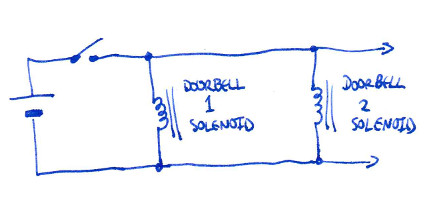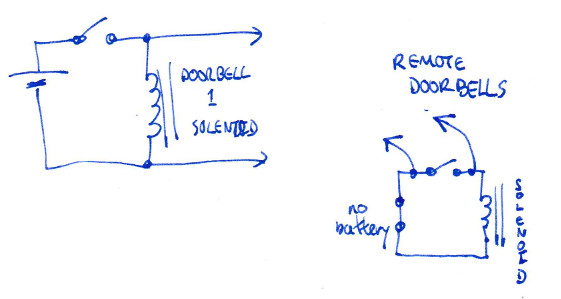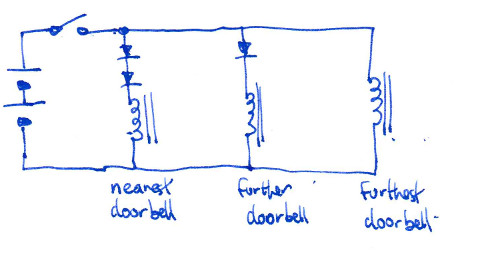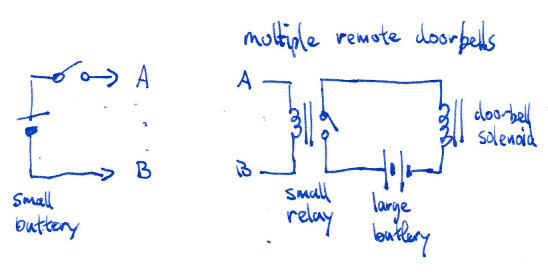Sometimes it's useful, or necessary, to have more than one doorbell ringer placed around a building, or multiple buildings, so that it's possible to hear the doorbell ring no matter where you are. This is not completely straight forward to do with most wired doorbells that you buy from the hardware store, but is do-able with a bit of ingenuity. The alternative, of using wireless doorbells with multiple receivers is possible, but doesn't always work in practice. The range of the signal mayn't spread as far as you need, or penetrate through the walls, or suffer conflicts with other wireless systems. Those were the problems that we faced, so we went with a wired solution.
One problem with wired doorbells is similar to wireless ones, distance—as the length of your wiring increases, you lose voltage along it, and mayn't be able to make a bell ring at the end of a very long wire. Or, more to this point, mayn't be able to make multiple bells ring. But you could be in luck, and may be able to simply wire up a system like this:

A single power source (usually a battery) goes through the front doorbell button, and goes to each doorbell ringer in parallel. Essentially, you're giving power to the solenoids that strike the chimes or ring the bells. However, you will need to modify each doorbell ringer, so you can wire-up directly to their solenoids. The easiest way to do that is to simply put a wire across the remote doorbells' battery terminals, to short the terminals out (naturally, you permanently remove the batteries from each remote doorbell's ringer).

But if you're like us, and needed to place bells at the ends of very long wires, the furthest ones didn't work with that arrangement (they didn't ring, at all), and an alternative is needed. You can try heavier guage wire, but that mightn't be enough to make things work, and rewiring is an awkward and expensive thing to do. Another option is to use a stronger power supply, but that can overwork the nearest bells, so you'd need to reduce their drive voltages. You could put some diodes in series with their solenoids, as simple voltage droppers, like this:

But again, that mayn't be enough to deal with very long wiring runs, and it's rather experimental to work out how many diodes you'd need at each ringer to reduce the voltage. And not practical if you're using AC-powered bells (you'd need a second set of diodes, in parallel, facing the other way). Yet another option is to reduce the amount of power required to activate each doorbell ringing. We went for the latter, and wired up a system like this:

A single power source (a small battery) goes through the front doorbell button, and two wires from this (marked A & B) go to each doorbell in parallel. At each remote doorbell is a small relay that only needs a small amount of current to activate, and it's this relay that's powered by the front doorbell button (the A & B wires go to its coil, polarity is unimportant). The contacts of these relays go to where the remote doorbell would have had its own press-button connected. Each doorbell has its own batteries, and operates just like a standalone doorbell normally would.
It works rather well, and allows us to use any doorbell without having to modify them. We just use our relay interfaces instead of their usual push-buttons. All the batteries last many years, since they're normally not supplying any power to anything. If the relays are small units, you may be able to power them from a single 9 volt transistor radio battery at the main doorbell button. That's what we've done.
This technique makes it easy to run almost as many doorbells as you'd like around a property (inside, outside, several rooms). And you can unplug individual doorbells, when you don't want to be disturbed, without affecting the others.
The one difficulty is if you use an illuminated push button. Most of them work with the globe across the switch, so there's a continual drain of current, making battery power unsuitable at the pushbutton. You need a small power supply transformer that's designed to always be connected to the mains. Many are not, so look for ones specially rated for always-on/24-hour use. You can buy supplies made for doorbells, modems, and alarm systems that are rated like that.
There's a second problem with illuminated push-buttons, in that the globe may pass enough current to activate all the relays, permanently. They tend to rely on the usual doorbell coils needing a hefty amount of current to strike, and the globe will not provide this, but it may supply enough current to activate small relays. A LED-illuminated doorbell button needs far less current to light, and may be a solution. Otherwise, you're faced with modifying the push-button enclosure, to separately power the light from the switch mechanism, or completely removing the light from the circuit.